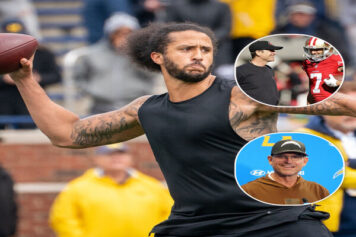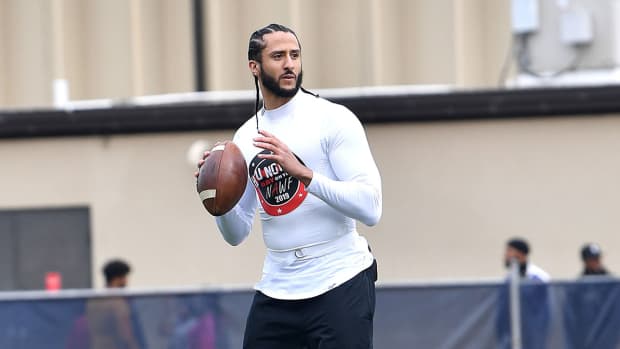The debate over the comparison between the NFL and chattel slavery has been chewed up, swallowed, regurgitated, spit out and reconstituted as a midnight snack many times over the past few decades.
In Colin Kaepernick’s coming-of-age new Netflix series, “Colin in Black & White,” the former quarterback and civil rights activist likens the NFL draft and combine to slavery in that the players have ‘no dignity’ and of course everyone lost their marbles in responding.
What Colin Kaepernick and Bill Rhoden are referring to with their comparison to slavery is the way that Blk athletes are traded and treated as commodities
They didn't mean it literally pic.twitter.com/3UiSooVk09
— Huey P's Student (@TenPointPG) October 31, 2021
As the first episode opens, a gathering of football players, portrayed by Black actors, are seen charging across a field in front of white coaches.
“What they don’t want you to understand is what’s being established is a power dynamic,” Kaepernick, dressed all in black, says.
“Before they put you on the field, teams poke, prod and examine you searching for any defect that might affect your performance,” he continues. “No boundary respect. No dignity left intact.”
Comparing Combine and Draft To Slavery Is Nothing New
The controversy dates back to the 1975 ending of the reserve clause in professional sports contracts, first in baseball, then in other sports.
At one time, it was common to compare professional sports with slavery when referencing the reserve era; sociologist Orlando Patterson describes the power of the reserve clause as one to allow “proprietors to sell and buy athletes against their will.”
This seems to be a clear, nearly inarguable (by today’s standards) parallelism, and yet, almost 40 years after the end of the reserve era, the comparison persists, particularly when draft time rolls around for the NFL.
In spite of the fact that American slavery was first and foremost an economic system, the backbone of the argument for the NFL as a modern-day slave trade has nothing whatsoever to do with money and everything to do with the bodies of black men.
More specifically, our nation’s obsession with sweat-glistened, overextended, pushed-to-the limit, black, male bodies. The fact that NFL players are paid handsomely for whatever freedoms—real or imagined—they have to give up is the card that makes the deck rigged.
Once someone slaps it down on the table, there is usually not much more to say on the subject. It is far easier, in today’s not-so-post-race America, to discuss the accessories of wealth that adorn black men’s bodies than to have a hard look at exactly what role black men’s bodies play in our lives and our markets.
The current articulation of this question as it pertains to NFL players, centers on The Combine, the yearly dog-and-pony show for college athletes entering the draft, in which the athletes perform various tests of strength and skill in front of team doctors and scouts.
And, in recent years, in front of a growing audience of fans who watch the spectacle on NFL Network.
Joe Simmons of The SportsFan Journal wasted no time posing the question: “ Is the NFL Combine a Modern-Day Meat Market?” Turns out, it’s a reasonable question.
White Overseers, Black Bodies
Given the fact that 70 percent of the players are Black and team scouts and doctors are overwhelmingly white, the images produced at the Combine call forth the slavery comparison at its grizzliest: the sight of scantily-clad, muscle-bound black men being measured under the gaze of white men with dollar signs for eyes brings the auction block to mind whether or not you want to acknowledge it.
And beyond the physical examination, there’s the sight of the black male body at work: running, jumping, exerting its energy to its limits for the ultimate satisfaction of the collective gaze of NFL stakeholders and fans.
To clarify things a bit here, let’s call on poet and scholar Elizabeth Alexander who put it plainly in a piece from her essay collection called The Black Interior: “Black bodies in pain for public consumption have been an American national spectacle for centuries.”
Alexander hits the particular significance of pain in a way that sheds a glaring light on the NFL Scouting Combine and the game of football, in particular. But for the purposes of this analysis, let’s expand that to include black bodies engaged in any project of labor, sex/lust, aggression and/or sport. Matt Taibbi has chimed in, citing the “creepy slave-auction vibe and armies of drooling, flesh-peddling scouts,” as part of the unique draw of the NFL draft season.
The way he describes the scouts reveals the underbelly of the fascination of the black male body; the words “drooling” and “flesh-peddling” don’t sound like words that should be applied on a sports field, but I would definitely use them to describe, say, the smattering of men still in the strip club at 6am or the lone pimp scuttling down an alley in the red light district as night falls.
Of course, it is perfectly reasonable for the owners of a sports team to want to assess the “product” before they “buy” it, but the racialization of the game of football as reflected in the racial makeup of the entire system complicates this picture.
As Alexander notes, it is “white men” who “have been the primary stagers and consumers” of the black male body impacted by violence and pain. And while the debate of whether or not football is egregiously violent, or just necessarily so, rages on between teenage boys and helicopter parents nationwide, one must only look at the size and stature of these super-men to assess exactly how rugged and rough you have to be to excel in the NFL at this point.
I cringe when I watch a big hit gone bad; I cover my eyes when the replays start as a player lies motionless on the field for even a few minutes. In fact, my eyes and my fingers do the same exact dance that shielded me from watching one Mandingo tear out the eye of another Mandingo (I have this on hearsay, obviously) as they fought to the death in Django, Tarantino’s most recent bloodbath-cum-celebrated film.
But it’s not just “the Man” who stands to gain from the spectacle of the Combine; for an athlete who suffers from a lack of buzz, the event stands out as a huge opportunity to strut his stuff in front of the people who matter.
This is an important distinction, particularly when the gruesome comparison is made to a slave auction, because no one entered slavery willingly or looked at a slave auction as a make-or-break chance to win big.
So why make the comparison at all?
Why risk disrespecting the legacy of the very ancestors whose shoulders black NFL players stand on?
https://twitter.com/ClayTravis/status/1454587678155067398
Because it is the increasing popularity of the Combine as an entertainment event in and of itself, and the underlying reasons behind that popularity, that reproduce the fetishization of the black male body that was born of this country’s past as a nation built by white slavers on the backs of African slaves.
Slavery was about power and control, so what is of interest here is the power dynamic between white owners and black players and the ways that dynamic is performed for our consumption.
The Combine offers a unique viewpoint into that dynamic because it is so explicitly about the bodies of the players. As stated earlier, white owners are often shielded from this kind of analysis because the image of the professional football player is hardly one of want; applied to the spectacle of the Combine, one could argue that the athlete, if he is a product, is a product of his own discipline and hard work.
The whiteness of ownership in the NFL rests at a semi-safe distance in this spectacle because it is not on display during the Combine. In an odd reversal, here whiteness is what lurks insidiously in the shadows.
Thelma Golden, curator of The Studio Museum in Harlem, is quoted in Cassandra Jackson’s book, Violence, Visual Culture, and the Black Male Body , calling the bodies of African American men “one of the greatest innovations of the twentieth-century…invented because black masculinity represents an amalgam of fears and projections in the American psyche which rarely conveys or contains the trope of truth about the black male existence.”
In everyday culture, we can see this in the black male face of crime, rage, sexism, homophobia and xenophobia. In the NFL Scouting Combine, we see it in the lack of any criticism, whatsoever, of the exhibition of white male bodies for team evaluation and viewing pleasure.
While researching this article, it was so hard to locate a discussion of the consumption of white male bodies related to the NFL that I found myself reading a white supremacist blog post about “the unbearable whiteness” suffered by white players who get passed over for skilled positions by throngs of lesser qualified black men through some kind of nasty affirmative-action-gone-wrong dramaturgy.
Can we say white male insecurity, people? Because that’s also a legacy of slavery.
The House Always Wins
And so, nowhere can we see Golden’s articulation more richly drawn than in the world of American sports and the NFL in particular, because (neo-Nazis notwithstanding) the success and visibility of these black men is tied to skill, effort, talent, and discipline.
It’s the non-racist (superficially, at least) version of ‘but he’s so articulate,’ used to describe prominent black academics and, ahem, Presidents.
What conveys truth better than a man running as hard and as fast as he can, stepping lightly as he jumps, flips, and rolls his way to glory? How better to deal with projected fear, than to put that man in a protective mask and a set of pads and send him off to pummel other men who look like him?
As long as the house always wins—and believe me, in the NFL and in any other white boys’ club still operating in this country, the house always wins—what happens on the field and what it took to get there is all just a part of the game.



